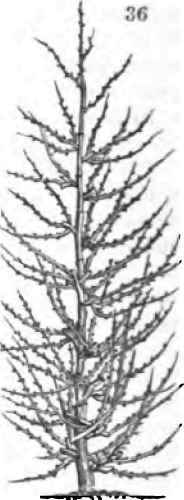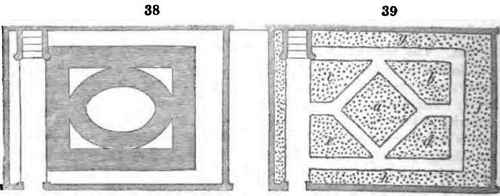128. General Arrangement
Description
This section is from the book "The Villa Gardener", by J. C. Loudon. Also available from Amazon: The Villa Gardener.
128. General Arrangement
In fig, 35., a is the entrance from the street; b, the steps to the front door; e, the hall and staircase; d, a library or business-room; e, breakfast parlour, school-room, or bed-room; f, dining-room; and g, drawing-room. This house is supposed to be only two stories high; the upper story containing two best bed-rooms, a servant's bed-room, a nursery containing a bath, and a water-closet; and the basement floor containing a kitchen, back kitchen, and other offices, with a servants' water-closet. The entrance to each house is protected by a porch, which is extended as far as the boundary wall on each side; thus forming a low horizontal roof, which will contrast effectively with the higher roof of the house. Beneath each porch there is a bench for sitting on. Both houses are surrounded by a platform, or terrace of pavement, 3 ft. broad, and 9 in. higher than the sur-face of the walk, and which covers a vacuity all round the house as deep as the foundations; thereby keeping it perfectly dry.
This platform also adds much to the dignity of the edifice, and forms a walk which is at all times firm, and comparatively dry and sheltered.
129. The front gardens are of turf, varied by flower-beds. That on the right has a rhomboidal figure in the centre, planted with gooseberries, with four semicircular beds round the central one, planted with strawberries. That on the left has a raised bed in the centre, with a border of turf, and four small diamond-shaped beds to harmonise with the rhomboidal bed in the right-hand garden. The centre bed may be filled with peat earth, and planted with Vaccinium madeirense, or some other species of Vaccinium which bears fruit freely; and the diamond-shaped beds may be planted with the wood strawberry. The fruit of the common bilberry (Vaccinium Myrtillus) arrives at maturity at the same time as that of the alpine, or wood, strawberry; and the two, when mixed together, and eaten with sugar and cream, are delightfully refreshing, as every one who has travelled in Poland or Sweden in the summer season must have experienced. In open, airy situations, the central bed might be planted with Rubus arcticus, which is also a most delicious fruit, with a flavour resembling that of the raspberry, but far superior.
If none of these fruits will thrive in the situation, or if peat soil to grow them in be thought too expensive, then the twice-bearing-raspberry may be planted, which requires no particular soil, but only to be taken up and have the soil renewed every four or five years; which, indeed, is the case with all travelling-rooted plants, which it is desired should continue to fruit freely. The row of trees adjoining the street fence is supposed to be damsons, which come early into flower; and the fruit, being small and thickly set among spines, is not easily stolen. The plants on each side of the party-railing may be gooseberries, currants, or raspberries, according to the taste of the occupier; or they may be dwarf apples. The row of detached standard trees between the entrance gate and the porch (b) may be pears, trained en quenouille; that is, distaff fashion (see fig. 36.); or en pyramide (see fig. 37.); by either of which modes they will occupy little space, and look well: some kinds also bear well when trained in these manners. Fig-trees or vines may be trained in the spiral manner round stakes.
Behind these trees, against the wall, we would train common laurels, laurustinus, or ivy; because, though currants or gooseberries would be more appropriate there, yet under the shade of the pear-trees they would not thrive; besides, if they would thrive, we think they ought to be sacrificed, in this particular spot, to the evergreens mentioned. We may observe, here, that the beds in which the strawberries are grown will be improved in effect if they are either surrounded with a marginal line of brick or tiles, or if the surface is covered by some description of stones, pebbles, flints, or vitrified bricks. The cause of this improved effect is, the contrast between rocky or stony materials and the turf.
130. To vary the plan of these gardens, figs. 38. and 39., for ornamental flowers, might be substituted for the front gardens, shown in fig. 35.; and provided the family residing in the house were fond of gardening, and wished for occupation in the open air, they might be planted as follows: for training against the upper part, Passiflora caerulea and Tecoma (Bignonia) capreolata (which, as fast growers, would need a good deal of training), and Rosa ruga, sanguinea, Noisettiafta, and other China roses, might be planted, which, during summer, would not only require training, but constant attention to keep down the aphides, and to remove the decayed blossoms and their stalks. If the aspect were east or west, Tecoma (Bigndnta) radicans, Lonicera flexuosa and grata, Wistaria sinensis, camellias, myrtles, and climbing roses, might be employed. The wistaria, the tecoma, and the evergreen climbing roses
Would reach to the top of the house, and the others would cover the lower part The myrtles and the camellias would require to be matted during the severest weather in winter, and the other plants would occasion a good deal of pruning and training during summer. On the supposition that the occupier of the house was a lady, we would not recommend any climber to be planted against the house that would grow higher than 4 ft. or 5 ft.; but such as myrtles, camellias, pelargoniums, fuchsias, etc, as these would not need the use of a ladder to train them. The side and front walls of the front garden may be covered with China roses, different varieties of honeysuckles, and Jasminum officinale. Against one of the side walls, if there he room, a double-flowering pomegranate may be planted in the centre; and against the others Magnolia conspicua or purpurea. In the beds in the interior of this garden, we would plant nothing but flowers; or we might devote the centre bed a in fig, 39. to moss roses, or to some other kind or kinds of rose belonging to sections different from those which include the China roses. In the centre of this rose-bed there might be a standard rose.
At the end of this work we shall give selections of roses, as well as of herbaceous perennial, biennial, and annual flowers.



Continue to:


